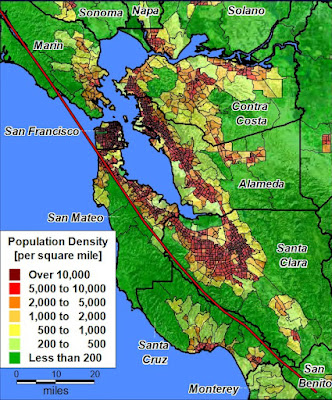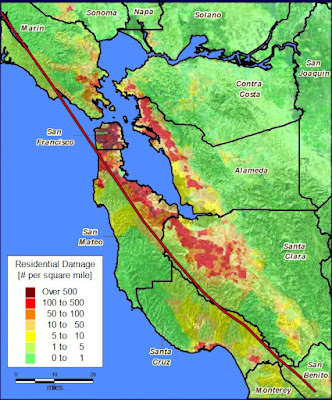San Francisco Earthquake Scenario
An earthquake scenario for the San Francisco area is one of the scenarios where finding more recent information is difficult. For an actual scenario, the best I could find was from a simulation in 2006. There was also some information from a 2008 ShakeOut Scenario.
There are more recent earthquake hazard and risk calculations available, but I have yet to find these risks and hazards incorporated into a full scenario, where costs and losses are calculated for the earthquake.
While the details may be a little different, the whole purpose of this, and other scenarios, is to help you start to grasp the magnitude of damage and loss that a large earthquake can cause. And will very likely cause.
Remember that California has generally had better earthquake building codes for a longer time than most of the rest of the United States. An earthquake of a much lesser magnitude can have just as much (if not more) damage and losses in an area where the buildings and infrastructure are not as prepared.
Please keep this in mind, the information (such as money, population, etc.) for this scenario is 14-16 years old (as of my writing this). While there are more people living in the area, most construction in the area will be more resilient to earthquake damage and hopefully will not contribute to increased deaths and injuries. That said, the economic damage will likely be much higher.
In 2006, an earthquake scenario designed to repeat the 1906 San Francisco earthquake was simulated among federal, state, and local California officials. The simulated earthquake had a magnitude of 7.9.
Once again, as we review some of the estimated damages, remember this information is from 2006. Today, costs would be much higher. Losses may also be higher due to increased population and development. While newer construction should be more resilient to earthquake damage, with the larger number of people in the area since 2006 there would still be a lot of people directly affected by a large earthquake. Hopefully the deaths and injuries would not increase.
In 2006 dollars, and based on assets at that time, the area had 1.1 trillion dollars’ worth of building exposure:
- $780 billion in residential
- $204 billion in commercial
- $43 billion in industrial
Over 10.5 million people (this is not just San Francisco but all cities in and near the Bay area) would be at risk, including 3.7 million households and 1.2 million people over 65 years old.
 |
| The population data of the San Francisco area in 2006. https://www.fema.gov/media-library-data/20130726-1742-25045-9381/dl_sfeqlosses.pdf (link not working) |
The projected damage from the simulation included the following:
- Of the 3 million residences, over 100,000 could potentially be destroyed.
- 10,000 commercial facilities are expected to have extensive, or worse, damage.
- 1,300 bridges of the 6,900 in the nineteen-county area may be damaged enough to require repairs.
- 30 to 50 of the area’s 120 hospitals may experience minor to major damage.
- 35 fire stations and 50 police stations may be seriously affected.
- 2 emergency operation centers would likely have significant damage.
- 400 of the 4,000 schools may be closed.
- 500 to 600 fires may ignite in the area, with about 100 fires in San Francisco.
- 25 to 40 million tons of debris would be generated.
- 200,000 to 300,000 households would be displaced.
- 60,000 to 120,000 people would require short-term shelter.
“A magnitude 7.8 is not the largest earthquake that the southern San Andreas Fault can produce, nor is the San Andreas the only fault to threaten the populated areas of southern California with very large earthquakes. However, those other faults have recurrence intervals (an estimate of the average time) between larger earthquakes that are considerably longer, measured in thousands of years. By contrast, the southern San Andreas Fault has generated earthquakes of ShakeOut size on average every 150 years—and on a portion of the fault that ruptures in the ShakeOut Scenario, the last earthquake happened more than 300 years ago” (The ShakeOut Scenario).
- At least 10 million people would be within the heavy shaking areas.
- Only 1,800 casualties would be expected, due to strong building codes, but tens of thousands of injuries would also be expected.
- All unreinforced masonry buildings within fifteen miles of the San Andreas Fault would be destroyed.
- Hundreds of older buildings will have collapsed into heaps. Thousands of other buildings will be so damaged they’ll eventually need to be torn down.
- The fault rupture would offset all infrastructure lines going into Southern California, including:
- Interstate-15 at Cajon Pass
- Interstate-10 at San Gorgonio Pass
- Route 14
- pipelines
- power lines
- roads
- railways
- telecommunications
- aqueducts
- At least 1,600 large fires will likely start, and many small fires will also start, possibly flaring up into larger ones. The fires could double the death count.
- Two-thirds of the hospitals in Los Angeles, Orange, Riverside, and San Bernardino counties will be non-functional.
- 50,000 people will be trying to get to emergency rooms.
- The state highway system will mostly survive, due to seismic upgrades, but many bridges and overpasses under the control of cities and counties won’t do as well.
- Many roads will be impassable due to damage, collapsed structures, or abandoned vehicles.
- The water distribution system will also not do well, and some buildings will be six months, or more, without water.
- Many of the buried water and sewer pipes will become cracked or broken with the earthquake. Initial cleanup in the newer, relatively undamaged buildings will likely need to be done without running water.
- Electricity will be out. Electric trains and elevators will likely not be functional. Non-working traffic lights will gridlock streets, with many drivers eventually deciding to make the long walk home.
- Phone systems will be unusable or overwhelmed by the number of attempted calls.
- Total economic impact and loss would exceed $213 billion.


Comments
Post a Comment